#vegan luxury restaurant Tokyo
Explore tagged Tumblr posts
Text
All You Can Eat Buffet: Indulge in Dubai's Most Satisfying Buffet Experiences

Dubai is a city that thrives on luxury, innovation, and culinary excellence. Among the myriad dining options, the all-you-can-eat buffet stands out as a quintessential experience. And when it comes to indulging in one of Dubai’s most satisfying buffet experiences, Toshi, the Pan Asian gem located in the heart of Dubai, takes centre stage.
A Culinary Journey Across Asia
At Toshi, the buffet is more than just a meal; it’s a culinary journey that spans the diverse and rich flavours of Asia. From the bustling streets of Bangkok to the serene sushi bars of Tokyo, Toshi brings together the best of Asian cuisine under one roof. The restaurant’s menu is a celebration of the continent’s most beloved dishes, offering a wide variety of options that cater to every palate.
As you step into Toshi, the ambience instantly transports you to an exotic world, with elegant décor that reflects the restaurant’s Pan Asian roots. The warm lighting, intricate woodwork, and subtle Asian motifs create an inviting atmosphere, perfect for a leisurely dining experience. Whether you’re dining with family, friends, or colleagues, Toshi provides a setting that is both comfortable and sophisticated.
The All-You-Can-Eat Experience
The star attraction at Toshi is undoubtedly the all-you-can-eat buffet. Here, indulgence knows no bounds, as you are invited to savour an extensive array of dishes that showcase the best of Asian cuisine. The buffet is thoughtfully curated to offer a perfect balance of flavours, textures, and aromas, ensuring that every bite is a delightful experience.
A Symphony of Flavors: Toshi’s buffet is a symphony of flavours, with each dish carefully crafted to represent the essence of its origin. Start your culinary journey with a selection of appetisers that range from crispy spring rolls and dim sum to refreshing sushi and sashimi. The sushi station, in particular, is a highlight, offering a variety of fresh, hand-rolled delicacies that are as visually appealing as they are delicious.
Live Cooking Stations: One of the most exciting aspects of Toshi’s buffet is the live cooking stations. Here, you can watch as skilled chefs prepare your food right in front of you, adding a touch of theatre to your dining experience. Whether it’s a sizzling stir-fry, a perfectly grilled skewer, or a delicate bowl of ramen, the live stations allow you to customize your meal to your liking. The chefs at Toshi are masters of their craft, and their expertise is evident in every dish they prepare.
A Feast for the Senses: As you make your way through the buffet, you’ll find an array of main courses that are sure to satisfy even the most discerning diners. From the rich and aromatic curries of India to the spicy and tangy flavours of Thai cuisine, Toshi offers a wide range of options that cater to all tastes. The buffet also features a variety of vegetarian and vegan dishes, ensuring that everyone can find something to enjoy.
Desserts That Delight: No meal is complete without dessert, and Toshi’s buffet does not disappoint. The dessert station is a treasure trove of sweet treats, featuring everything from traditional Asian desserts to more familiar favourites. Whether you’re in the mood for a light and refreshing fruit salad or a decadent slice of chocolate cake, the dessert selection at Toshi is sure to satisfy your sweet tooth.

A Unique Dining Experience
What sets Toshi apart from other buffet experiences in Dubai is its commitment to quality and authenticity. Each dish is prepared with the finest ingredients, ensuring that every bite is bursting with flavour. The chefs at Toshi take great pride in their work, and this is evident in the care and attention that goes into every dish.
In addition to the exceptional food, Toshi also offers a unique dining experience that is both interactive and immersive. The live cooking stations allow you to engage with the chefs and learn more about the dishes you’re enjoying, while the beautifully designed dining area provides a serene and elegant backdrop to your meal.
The all-you-can-eat buffet at Toshi is not just about quantity; it’s about quality. Each dish is carefully crafted to showcase the best of Asian cuisine, and the variety of options ensures that there is something for everyone. Whether you’re a fan of spicy curries, delicate sushi, or hearty stir-fries, you’ll find plenty to love at Toshi.
Perfect for Any Occasion
Toshi’s all-you-can-eat buffet is the perfect choice for any occasion. Whether you’re celebrating a special event, enjoying a meal with loved ones, or simply looking for a place to unwind after a long day, Toshi offers a dining experience that is both satisfying and memorable.
The restaurant also offers private dining options, making it an ideal choice for corporate events, family gatherings, or intimate celebrations. The attentive and professional staff at Toshi are dedicated to ensuring that every aspect of your dining experience is perfect, from the moment you arrive to the moment you leave.
A Culinary Destination in Dubai
Dubai is a city that is known for its world-class dining options, and Toshi is proud to be a part of this vibrant culinary scene. With its all-you-can-eat buffet, Toshi offers a dining experience that is both indulgent and authentic, allowing you to explore the rich and diverse flavours of Asia in a single meal.
Whether you’re a resident of Dubai or a visitor to the city, Toshi’s all-you-can-eat buffet is a must-try experience. The restaurant’s commitment to quality, authenticity, and exceptional service ensures that every visit is a memorable one.
So, if you’re looking for a buffet experience that goes beyond the ordinary, head to Toshi and indulge in one of Dubai’s most satisfying buffet experiences. With its wide variety of dishes, live cooking stations and elegant ambience, Toshi offers a dining experience that is truly one-of-a-kind.
0 notes
Text
Navigating Global Cuisines: A Travel Foodie's Guide
For many travelers, exploring the world isn't just about the landscapes, cultures, or activities—it's about the flavors, aromas, and culinary adventures awaiting in every corner. After all, what better way to connect with a new place than through its food? From the bustling street markets of Bangkok to the cozy bistros of Paris, let's embark on a gastronomic journey and see how you can make the most of global cuisines as a travel foodie.
1. Street Food: A Taste of Authenticity
Street food offers a window into the soul of a place. It's where traditional flavors meet innovation.
Bangkok: Dive into Pad Thai, freshly made from street carts, or savor Mango Sticky Rice.
Marrakech: Relish Moroccan treats like M'smen (a square-shaped flatbread) or Harira soup at Jemaa el-Fnaa.
2. Fine Dining: A Gourmet Experience
Luxury restaurants provide a unique blend of ambiance, presentation, and culinary artistry.
Tokyo: Experience the meticulous craft of Kaiseki, a traditional multi-course Japanese meal.
Paris: Savour gourmet dishes at Michelin-starred restaurants, accompanied by world-class wines.
3. Local Markets: Fresh Produce and Traditional Ingredients
Local markets offer fresh ingredients and a glimpse into daily culinary practices.
Barcelona: Visit La Boqueria to find fresh fruits, cured meats, and a variety of cheeses.
Mumbai: Crawford Market will mesmerize you with its array of spices, dried fruits, and local snacks.
4. Cooking Classes: Delve Deeper
Why just taste when you can learn to cook? Many destinations offer cooking classes for tourists.
Rome: Master the art of pasta-making.
Chiang Mai: Learn the intricacies of Thai cuisine, from Tom Yum soup to Green Curry.
5. Unique Dining Settings: Elevate the Experience
Sometimes, it's not just about the food but where you eat it.
Maldives: Enjoy a meal in an underwater restaurant, surrounded by marine life.
Cappadocia: Relish a traditional Turkish breakfast in a cave setting or on a terrace overlooking hot air balloons.
6. Dietary Restrictions: Navigating Challenges
While exploring global cuisines, dietary restrictions needn't dampen your food adventure.
Apps: Use applications like HappyCow for vegetarian and vegan-friendly restaurant recommendations.
Translation Cards: Carry cards explaining your dietary restrictions in the local language.
7. Beverage Trails: Beyond Food
Every cuisine has its signature drinks, from teas and coffees to wines and spirits.
Tuscany: Embark on wine tasting tours, sipping the region's finest Chiantis.
Kyoto: Experience traditional tea ceremonies, understanding the Zen behind each sip.
8. Seasonal Delights: Timing Your Visit
Some culinary experiences are bound by seasons.
Germany: Visit during Christmas to enjoy festive treats like Lebkuchen and Glühwein at Christmas Markets.
Japan: Spring offers Sakura-themed dishes and beverages, celebrating cherry blossom season.
9. Culinary Festivals: A Gastronomic Celebration
Align your travels with global food festivals for a heightened experience.
Melbourne: Taste your way through the Melbourne Food and Wine Festival.
Lima: Join the Mistura Festival to explore the diversity of Peruvian cuisine.
10. Local Etiquettes: Respecting Traditions
Understanding local dining etiquettes ensures respectful interactions.
South Korea: Never stick your chopsticks upright into a bowl of rice—it's considered disrespectful.
India: Eating with hands, especially the right hand, is common and often appreciated.
Conclusion
Traveling the world as a foodie is more than just satiating hunger; it's about immersing oneself in the stories, traditions, and people behind every dish. As food writer M.F.K. Fisher aptly put it, "First we eat, then we do everything else." And in the world of travel, food often becomes the central narrative, weaving tales of history, culture, innovation, and sheer passion.
As you map out your next travel destination, let your palate lead the way. Seek the spices, chase the aromas, and let every bite be an exploration, a revelation, and a celebration. Here's to global adventures and culinary trails that leave a lasting taste! Safe travels and bon appétit!
1 note
·
View note
Text
The Best Candles in Sydney
If you're looking for the best candles in Sydney, you've come to the right place. You'll be able to find the best scented products that are made from natural ingredients and high-quality fragrances. So, whether you want a light scent or something more aromatic, you're sure to find what you're looking for.
No 27 Fragrance House
If you're looking for a unique gift for your sweetie, look no further than No 27 Fragrance House candles. These Australian made candles are handcrafted from a coconut and soy wax blend and boast a burn time of 35 hours. A quick browse of their website and you'll discover that they also produce a range of scented mugs, baubles and baubles. Their candles have been designed to be a classy addition to any home decor scheme.
Glasshouse Fragrance
Glasshouse Fragrance Candles are some of the best smelling candles on the market. They use a blend of non-toxic soy wax and natural cotton wicks to deliver a smooth, long-lasting burn. A Glasshouse candle is the ideal way to elevate your home decor while adding a touch of glamour to your space.
There are many Glasshouse scents to choose from. One of the most popular is the A Tahaa Affair, a fragrance that combines sweet notes with a hint of citrus.
Aery Living
The Aery Living collection has a beautiful range of candles, essential oils, and room sprays. All of the products are free of petrochemicals and are made with sustainable materials. Each product has been specially created to enhance wellbeing.
In addition to their candle collections, Aery also offers reed diffusers and bath salts. All of the products are environmentally friendly and come in cruelty-free packaging. They are also vegan and made from natural ingredients.
Cire Trudon
The French brand Cire Trudon has been making candles for nearly 350 years. They are considered to be the best candles in the world. Their signature green glass is one of their most famous. These artisanal candles are made with paraffin-free wax and pure cotton wicks.
Trudon is a family-run candle manufacturer. It was started by Claude Trudon, who began his candle-making career in 1643. He eventually became an official supplier to the court of Louis XIV.
Aesop
Aesop is a brand of luxury beauty and body care products that is popular in Australia and internationally. They offer a range of hair care and body care products, and are available in stores like Holt Renfrew, Nordstrom, and Ogilvy. In addition to their body care products, the company also produces candles.
The first candle to be launched by Aesop is the Callippus Aromatique. It's inspired by the ancient savant, who had a deep appreciation for the universe and the awe of the earth. This candle's fragrance has a blend of woody, earthy, and spicy notes.
Diptyque
The luxurious Diptyque candle brand is famous for its signature, mind-soothing scents. These candles are hand-poured and crafted in France from the highest-quality materials. They are a great way to gift someone with a beautiful, memorable present.
For a more affordable option, you can buy Diptyque candles in miniature sizes. Mini candles are perfect for people who want to try the brand without committing to a full-sized candle.
Smith and Co.
The Smith and Co., an Eau Claire-based candle company has a knack for creating the right balance of scent and design, and the best part is that you can enjoy their fine fragrances right from your home. Whether you choose to light their wares at home, at the office, or in your neighborhood grocery store, the best part about their scented candles is that their signature scents are made from 100% soy wax and contain a lead-free wick.
A Moment in Tokyo
Tokyo is a city where old and new converge. This is especially true when it comes to food. Many of the yokocho (Japanese alleyways) have small bars and restaurants that serve traditional Japanese dishes.
The Ginza Okuno building is a beautifully preserved landmark in the heart of the Ginza district. It has many art galleries and antique shops. Some of the rooms are time capsules, and others are left as they were when the building was last occupied.
Lumira
The Lumira luxury candle collection celebrates the beauty and sophistication of fragrance. Made with creamy soy wax and fresh fragrances, this collection of candles is perfect for romantic nights in.
Founded by Sydney-based creative director Almira Armstrong, LUMIRA embodies the spirit of travel. Inspired by exotic destinations around the world, their fragrances are crafted by hand in Australia using the finest ingredients.
Palm Beach
Whether you're a candle lover or you're just looking for something nice to add to your home, you can find a variety of candles in Sydney. Besides their great scents, you can also find candles that are made from soy, which is renewable and eco-friendly. You can choose from a variety of sizes and shapes. Whether you want a traditional glass jar or a more contemporary design, you'll be able to find a candle that suits your style.
0 notes
Photo

🍽• • • Art of plating. Everyone has there own unique style and signature even when same techniques are used. What do you think? 🤔 Comment 👇 • • • ❤Like 🚀Share 📲Save 👨🏻🍳 ~ Chef @salih_sarkn 👏 ___________________ 📸 All rights & credits are solely to the owners(s) 📌 Stay tunned for news & new content 👇 👇 👇 👇 👇 @chefsland_ ~ @chefsland.tr ~ @chefsland.ru : : : #instagood #instagram #instafood #instachef #food #eat #miami #newyork #california #vegan #lunch #breakfast #foodie #foodporn #privatechef #chefslife #love #brunch #restaurant #gastronomy #luxury #finedining #plating #reels #pastry #art #yummy #dessert #hungry #fruits (at Tokyo Japan) https://www.instagram.com/p/CmgqpigokUe/?igshid=NGJjMDIxMWI=
#instagood#instagram#instafood#instachef#food#eat#miami#newyork#california#vegan#lunch#breakfast#foodie#foodporn#privatechef#chefslife#love#brunch#restaurant#gastronomy#luxury#finedining#plating#reels#pastry#art#yummy#dessert#hungry#fruits
0 notes
Text
What can I see in Japan in 7 days?
Japan is, due to its remoteness and quirkiness, a dream destination for many Westerners. The common opinion is that to fully experience wonders of the land of the Rising Sun, one should plan for at least a ten-day long vacation. However, I still think that a week-long trip to Japan is a great idea for a spring or autumn break.
I traveled to Japan in the fall of 2018 when the weather was just perfect with almost no rain and the temperatures between 20 and 25°C. Itinerary-wise, I chose to do the best of (and ideal for the first trip to) Japan: Osaka – Kyoto – Tokyo tour, flying to Osaka and leaving from Tokyo, and I would like to present you the 10 highlights from my trip.

1. Visit the Osaka Castle
Depending on where you are located, it is good to go visit Osaka Castle first, and during the day, as it is situated a bit separately from other tourists’ sights. This is a pre-Edo era fortress and a castle with a large moat, fortified with a wonderfully executed stone wall. The castle itself is an architectural eye candy rising in the middle, that you can climb and get a view of Osaka skyline for as cheap as 600 JPY (5 USD).
2. Osaka City Center in the night: Dotombori, Takoyaki
In the evening, I suggest you hit up the Dotombori area for a postcard-worthy picture of the Moving Crab or the Swimmer neon poster. Take a stroll down the main shopping street that is so lit up with LEDs and neon lights in the night that you will lose every impression of the night sky above. This is a great place to try Takoyaki, the Japanese seafood balls that originate from this area. The big (moving) models of crabs, octopuses, and squids are to indicate the kind of food that the restaurant is serving, so use them as a guide.
3. Walk the Shinsekai in Osaka, The Tsutenkaku Tower, Kushikatsu
Shinsekai is an old, colorful, part of Osaka ironically called the New World. Well, once it was new, in the 1920s that is, when it first emerged. The area was modeled by New York and Paris of that time, with the Tsutenkaku Tower dominating the neighborhood in the middle. It allows for another great view of Osaka skyline, but also to the Shinsekai from above. This area is famous for Kushikatsu –panko covered, deep-fried skewers made of vegetables, meat, eggs, cheese and the mixture of it. It is suitable for vegans as you can select only vegetables on your menu.

4. Go to the Osaka Aquarium
The central tank of this aquarium features a couple of whale sharks and that alone is a big reason to visit the Osaka Aquarium located in the eastern part of the city and easily reachable by the subway. Apart from the sharks, which is the aquarium’s main attraction, this place showcases not only a huge variety of marine life from the world’s seven seas but rivers, creeks, and lakes as well such as otters, birds, and even penguins!
5. The Imperial Palace of Kyoto
Kyoto is Japan’s old capital and hosts the second active palace of the Emperor – The Imperial Palace of Kyoto. Enjoy the free tour of walking the vast courtyard with traditional Japanese architecture and gardens with lakes and bridges, posing for some fantastic photo opportunities. Located centrally, it is easily reachable from every part of the city.

6. Kyoto downtown: Nishiki Market, Gion district and The Yasaka Shrine
If you are in for some shopping, check out the center of Kyoto – The Nishiki shopping area with both high-end boutiques and Asian covered bazaar markets. On a walking distance from there stands Gion, the old, geisha district of Kyoto. Stroll down the romantic streets on of Gion heading east and you will reach the Yasaka Shrine, a popular tourist spot. Before you enter the Shrine, I advise you to try Pablo’s cheesecake tarts which stand just a couple of hundreds of meters on the left side of the entrance.
7. Kyoto - Kodaiji Temple, Fushimi Inari Shrine, and climb the mountain for the views
For a more spiritual experience, walk south from the Yasaka shrine and experience the Kodaiji Temple, the ceremonial Japanese garden where traditional weddings happen and walk the mini bamboo forest that they have in the small hill behind the temple. The entrance fee is 600 JPY. Then you can take a train south from there to Fushimi Inari Shrine, (the main shrine of the god Inari) which is represented on most postcards from Kyoto: an array of orange arches called Torii leads towards the top of a hill where you may feel as a pilgrim, but the top promises you some great picture worthy openings.

8. Tokyo – The Centers: Shinju-Ku and Shibuya
Take a bullet train from Kyoto to Tokyo for a great traveling experience. Taking about 3 hours to reach it from Kyoto, Tokyo is a gigantic city, so one should not even dream of seeing it all in 3 days, but it is definitely enough to scratch the surface. After the traditional Kyoto, you may be hungry for some futuristic views. Head to Shinju-Ku in the evening and Shibuya in the night and experience the lights of Tokyo at their prime.
9. Tokyo - Akihabara and the Kitchenware district
Akihabara is the electronic and gamer’s town of Tokyo – “Otaku district”. For all the geeks and anime lovers, this is the right area to browse vintage video game stores, comic and toy collector stores, maid cafes and other quirky stuff. Not far away from there is the Kitchenware district in a street of Kapabashi. Here you can find any kind of kitchenware, but most of the people come to purchase a Japanese knife, known for their quality, precision, and durability.

10. Tokyo – The Imperial Gardens, Roppongi and Akasaka
Scratch the surface of the cultural experience of Tokyo by walking the Imperial Palace garden. Only East garden is open for public admission, while you can preregister for an organized tour of the palace itself. You can have an afternoon tea in a bar of the Imperial Palace Hotel which is an attraction of Modernism architecture in itself, offering numerous restaurants and luxury shopping experience. Hit Roppongi and Akasaka for some excellent eats in the evening. Both of these neighborhoods are located close by and are in a walking distance from each other. They offer great bars, restaurants, and cafes for you to enjoy and relax after this amazing and trip.

Bonus tip: Try to book a hotel with a Japanese spa in Tokyo. It will help you unwind at the end of every day full of experience, and the sauna and hot water of the spa will do miracles for your tired feet!
12 notes
·
View notes
Photo

Simple Vertical Channel back Banquette Restaurant Booth Seating, Available in dozens of colors, sizes and styles: https://tinyurl.com/banquette-booth-seating #restaurantinteriors #restaurantfurniture #blue #walnutwood #woodworking #woodtables #naturalwood #asianfood #restaurant #molding #interiordesign #banquetteseating #cherrywood #beechwood #inspiration #california #tokyo #sunnyday #luxury #simple #wood #natural #earth #vegan
0 notes
Text
Earth Day 2021: The Best Vegetarian And Vegan Tasting Menus In Asia

Summer time bean salad at Jaan by Kirk Westaway in Singapore

By Rachel Duffell
April 22, 2021
From plant-based set dinners to vegetarian and vegan tasting menus––these nice eating eating places in Asia supply distinctive experiences for vegetable-forward diners
Newsletters
Join our newsletters to get all our prime tales delivered.
Newsletters
You have Efficiently Subscribed
Tasting menus typically exclude vegetarians and vegans––and even these with different dietary necessities. And whereas these diners can simply go for a devoted vegetarian or vegan establishment, generally it’s good to have the ability to flip up at a flowery restaurant and go for a available, tried and examined vegetarian or vegan set menu, or to be catered for by cooks accustomed to and able to heed such requests. We scoured Asia’s best eating places to search out our favorite tasting menus devoted to the vegetarian and/or vegan diner.
Lots of Hong Kong’s nice eating eating places supply a minimum of a vegetarian if not a vegan tasting menu on request. Amber’s Vegetarian Amber Expertise and Full Vegetarian Amber Expertise shine as standouts. Since culinary director Richard Ekkebus’ overhaul of Amber, the place he shifted focus to lighter flavours and components which are kinder to the planet, his vegetarian tasting menus––which could be tweaked for vegans––function delights that incorporate rigorously sourced vegatables and fruits and a bunch of intriguing components.
Arcane is one other wonderful choice. Agency favourites among the many restaurant’s many followers embrace the sautéed potato gnocchi with shiitake ragout, spinach, pine nuts and black truffle, and the Japanese fruit tomato with burrata, black olive, salsa verde and focaccia crips, each of which come from the vegetarian à la carte but in addition function on chef Shane Osborn’s five-course vegetarian tasting menu (a vegan model can also be out there) alongside along with his basic yuzu and lemon posset––a dessert to not be missed.
For these looking for Asian flavours, conventional Cantonese restaurant Rùn at The St. Regis Hong Kong caters to vegetarians with a six-course vegetarian lunch and a seven-course dinner set, each of which change with the seasons and most of the time are additionally vegan given dairy’s rare look in Cantonese delicacies. Chef Hung Chi-Kwong’s refined flavours shine as a lot in his meat-free dishes as they do in his common menus. Vegetarians eager to show up the warmth ought to hunt down Indian nice eating hotspot Chaat at Rosewood Hong Kong the place, with advance discover, chef Manav Tuli brings collectively plant-based highlights from his à la carte, together with dal panchmel and palak paneer, in a punchy, spice-forward expertise.
Associated: Tatler’s Ultimate Guide to Vegetarian and Vegan Dining in Hong Kong
In Macau, nice eating lovers on the lookout for a plant-based method will adore Yí’s Vegetarian Tasting Menu. The regional Chinese language restaurant, positioned in Morpheus at Metropolis of Desires, solely affords ten-course seasonal degustation menus, and though altering often, the culinary delights included on latest vegetarian variations embrace gluten puff tartelette with seaweed caviar, fowl’s nest with white fungus and bamboo pith, and roasted eggplant with yellow bean paste.
Singapore has an inexpensive vary of vegan and vegetarian eating places, however on the subject of nice eating, head to Alma by Juan Amador the place chef Haikal Johari brings Asian influences, notably from Japan, to his modern-European dishes. With a three-, four- or five-course vegetarian menu out there at lunchtime, Johari additionally affords vegetarian choices for his 5 Act Découverte menu, in addition to his 7 Act Journey menu. The latter focuses on a cornucopia of engaging Japanese vegetal delights, from Tochigo strawberries and Tokyo turnips to Kyushi bamboo shoots and maitake mushroom, every rendered in luxurious preparations. In the meantime, at Jaan by Kirk Westaway, there’s a vegetarian model of the chef’s #ReinventingBritish Menu, with delights corresponding to hen’s egg with mushroom, inexperienced asparagus and braised lettuce, and saffron pasta with romanesco.
Associated: 5 Plant-Based Dishes Offered at Restaurants in Singapore That Will Inspire You to Eat Clean
Whereas Malaysia’s nice eating scene is comparatively small, there are a handful of eating places that cater to the plant-forward crowd. At Restaurant au Jardin, certainly one of Tatler Dining Malaysia’s Top 20 Restaurants 2021, minimising the carbon footprint is the secret. Situated in Georgetown, Penang, chef Su Kim Hock works with native farmers and suppliers to supply extra sustainably and, as such, affords a ‘Inexperienced’ Degustation Menu throughout dinner, in addition to a 5 Plats Vegetarian set at lunch time. Altering with the seasons, diners may take pleasure in contemporary buratta with cilantro and spinach purée, masala, capsicum jerky and cilantro oil, or tarte de petit pois with smoked cream, nori tarte, sherry vinegar gel, crispy leeks and skinned petit pois.
Over within the capital of Kuala Lumpur, guests to fellow Prime 20 Restaurant Nadodi, which affords “nomadic delicacies” that may be a playful tackle South Indian meals, caters to the big proportion of Hindu Indian vegetarians––in addition to vegetarians extra broadly. The Vegetarian Nadodi Expertise is a nine-course journey by the south of the sub-continent by way of delights like battered peanut okra bajji with yuzu kosho chutney, and kosho-glazed Highland asparagus with stuffed morel and inexperienced emulsion.
Associated: 5 Plant-Based Eateries In The Klang Valley
Tremendous eating eating places within the Philippines are fairly accommodating of plant-based diners, although superior discover upon reservation is most popular. At Toyo Eatery, a Filipino restaurant that delivers the flavours, traditions and strategies of the nation, an eight-course plant-based vegan menu could be ready that can have diners delighting within the refined flavours of chef Jordy Navarra. At fashionable Filipino restaurant Gallery by Chele, chef Chele Gonzalez prefers a minimum of someday’s discover to cater to vegans for his tasting menu, however has vegetarian tasting menus for each his 5 and nine-course units on the prepared, the place dishes may embrace a mushroom ceviche with pickled radish and cashew cream in lime, or bamboo and ginataang squash. At Metronome, the place “refined casual” French delicacies is on the menu, each vegetarian and vegan choices are available for any and all walk-in plant-based diners.
Associated: Where To Eat: Manila’s Hidden Gems For Vegans And Vegetarians
Thailand’s nice eating eating places supply a variety of cuisines on the higher finish of the eating scale and are pretty pleasant in direction of vegetarian and vegan diners. Indian chef DK’s Haoma affords a 10-course plant-based tasting menu with dishes corresponding to dal matter ki kachori with spinach spheres, inexperienced mung lentil and kachori cracker, and Hyderabadi gucchi biryani with morel biryani rice, mirch ka salan and burani raita. Every dish options home-grown natural, native Thai components ready alongside flavours influenced by his Indian heritage. Persevering with the Indian theme, Garima Arora’s famed restaurant Gaa additionally affords a vegetarian menu and might accommodate vegan company with prior discover. For Thai flavours, R-Haan has a vegetarian menu and, with discover, can customise it to be absolutely vegan.
Associated: The Pioneers And Caterers Of Bangkok’s Vegan Awakening
At PRU, Western-style dishes incorporate components grown within the restaurant’s backyard. There’s a 5-course vegetarian menu the place exotically named dishes corresponding to Flaura and Fauna of Mai Khao that includes berry tomatoes and jicama katsuobushi, and The Forgotten Greens with solar choke and spring onion are sure to thrill, whereas Mia affords each a 5 course vegan and a five-course vegetarian tasting menu with highlights corresponding to textures of artichokes with nasturtium and seaweed dressing, and barley risotto with spring peas, asparagus and 36-month outdated parmesan. At fashionable French restaurant Chef’s Table, diners can anticipate finding dishes like beetroot texture risotto with blackcurrant and juniper berry sauce, potato gnocchi with black truffle tapenade, leek and celery, and eggplant ravioli with ratatouille on the devoted vegetarian tasting menu.
Associated: How Well Do Fine Dining Restaurants In Thailand Cater to Plant-Based Diners
In Vietnam’s buzzing Ho Chi Minh City, Anan Saigon, which was not too long ago within the highlight on account of being the one Vietnamese restaurant to function on Asia’s 50 Best Restaurants 2021, affords each a pretty tasting menu and a vegetarian model of it. Chef Peter Cuong Franklin consists of such delights as banh xeo tacos with pickled shitake, blended mushroom, tofu vermicelli and peanut sauce, crispy silken tofu with togarashi chilli, lemongrass and sesame soy sauce, and a truffle mushroom Da Lat pizza with black truffle, cultivated mushrooms, quail eggs, mozzarella and herbs, amongst different interesting dishes.
Associated: Why Ho Chi Minh City’s Evolving Dining Scene Has Never Been More Inviting
At Taiwan’s top-ranking restaurant, Le Palais, which holds three Michelin stars, diners take pleasure in a number of the best Cantonese delicacies and it’s refreshing to see that vegetarians are additionally catered to with a devoted set menu that encompasses such delights as pine mushroom soup with bamboo piths and Chinese language yam, and braised white gourd full of edible fowl’s nest. One caveat––the menu is simply out there for 2 company or extra.
Richie Lin’s famend fine-casual restaurant Mume, which showcases Taiwan’s excellent contemporary produce by fashionable western and Nordic strategies, may cater a vegetarian menu (it comprises eggs and dairy) with three days discover previous to eating, although is unable to cater to vegans. And sticking to the western theme, Molino de Urdániz, a restaurant initially established in Spain, affords up to date European delicacies with Japanese undertones and at each lunch and dinner company can take pleasure in an eight-course vegetarian menu that takes diners by a various assortment of vegetable-based dishes.
South Korea has a robust tradition of temple food, which originated with Korean Buddhist monks centuries in the past and takes a ‘much less is extra’ method utilizing vegan components. Whereas there are eating places devoted to this delicacies, for these diners who wish to indulge at eating places that aren’t targeted on such easy fare, why not attempt Jungsik, the place chef Yim Jung-sik presents up to date Korean delicacies. A devoted vegetarian tasting menu affords delectable dishes corresponding to burdock gimbap, and neungi broth ravioli, each fantastically introduced.
Exterior of Okinawa, the place greens often take centre stage, Japan isn’t the simplest place for vegetarians and vegans to indulge, notably in the event you take into account nice eating eating places the place sushi and different seafood objects, in addition to Wagyu beef, typically function. Pierre Gagnaire Tokyo caters to each vegetarians and vegans, so long as advance discover is supplied, however for these looking for extra native fare, at Ise Sueyoshi, chef Yuuki Tanaka will adapt his conventional kaiseki dinner to cater to each vegans and vegetarians. He not too long ago additionally launched a particular vegan prix fixe menu, which is out there on the final Sunday of each month.
India is an effective place to go to as a vegetarian, notably you probably have a penchant for plant-based nice eating. Given the comparatively massive proportion of vegetarians in India, lots of the nation’s best eating places have tasting menus devoted to those that observe this eating regimen. Among the many most attention-grabbing, Avartana in Chennai has seven-, nine-, 11- and 13-course choices the place the tasting portion-sized dishes see greens rendered creatively utilizing molecular gastronomy, whereas at Masque in Mumbai, chef Prateek Sadhu prepares each a vegetarian and a non-vegetarian ten-course tasting menu, the previous that includes delights like candy potato paniyaram, and morel and gutti aloo. At Indian Accent in New Dehli, a vegetarian chef’s tasting menu options thought-about plant-based dishes corresponding to steamed soy keema gujiya with pickle and wild rice, Kashmiri morel musallum with chenna and saffron, and roomali paneer with candy pepper, roast tomato and makhni.
The huge expanse of China little doubt affords vegetarians and vegans quite a lot of choices on the subject of eating out, however there may be one key vacation spot for plant-based diners with a penchant for the finer issues in life––and that may be a seat at Shanghai’s Fu He Hui. The restaurant is an exception in comparison with the opposite eating institutions on this record, as it’s devoted solely to vegetarian delicacies. Nevertheless it’s a spot that attracts diners whether or not they observe a strict vegetable-based eating regimen, are inclined to a extra flexitarian method, or are full-on carnivores. Devoted to discovering the wonders of unique fungi, intriguing dishes incorporate a variety of mushrooms, aquatic crops and seaweeds, in addition to extra acquainted greens corresponding to gourd and taro. The restaurant’s design is impressed by Zen Buddhism with a easy, calming atmosphere and the selection of its easy, basic or seasonal set menu could be accompanied by a tea pairing. A meal at Fu He Hui is an expertise for diners to recollect, regardless of the eating regimen they favour.
Associated: Why Plant-Based Dining Is Taking Over The World
Source link
source https://fikiss.net/earth-day-2021-the-best-vegetarian-and-vegan-tasting-menus-in-asia/ Earth Day 2021: The Best Vegetarian And Vegan Tasting Menus In Asia published first on https://fikiss.net/ from Karin Gudino https://karingudino.blogspot.com/2021/04/earth-day-2021-best-vegetarian-and.html
0 notes
Text
The Trailblazers of Boutique: SLH Award Winners 2020
Individual, intimate, and inspirational in every way, this year’s SLH Award Winners embody the very best of our independently minded portfolio of boutique hotels around the world, from a carbon neutral eco-duo in Lake Garda and The Dolomites to a meticulously restored one-thousand-year-old castle with interiors handpicked by an Italian Count. In a time of unprecedented change and uncertainty, these hotels are still making the everyday extraordinary, and taking the many challenges they have faced this year in their stride.
“By recognising these exceptional hotels we celebrate not only our heritage as the pioneer of boutique but also embrace the future as custodians of our planet. As the winner of Hotel of the Year and our Stay Small, Stay Considerate Award, Lefay Resorts is a shining example to all of how luxury and sustainability can complement each other. However, sustainability is now also about supporting our hospitality industry, and the communities that they in turn support. All these remarkable hotels are open, or opening imminently, and ready to welcome back guests to demonstrate just why independent hotels are so very special.” Richard Hyde, Chief Operating Officer
In contrast to previous years, this year several of the awards were voted for by a panel of experts from the worlds of luxury, travel, wellbeing and cuisine – Simon Leadsford (Publisher, Condé Nast Traveller), Katy Simpson (CEO, Noble Isle), Michelin-starred chef Dominique Crenn, Carol Duval-Leroy (Owner, Champagne Duval-Leroy), Gary Allen (Managing Director, Luxury Travel Media) and Gisele Orellano (Co-Founder, Hermana Creatives).
Hotel of the Year – Lefay Resort & SPA Lago di Garda, Italy

Taking inspiration from the tiered lemon houses of Lake Garda, Lefay Resort & SPA Lago di Garda has been awarded our Hotel of the Year award for its strong eco-friendly philosophy and outstanding wellness area combining classical Chinese medicine with Western scientific research. Offering highly customized treatments designed to cure stress and insomnia, Lefay SPA extends over 3,800 square metres boasting six saunas of varying temperatures, an ice pool and a large salt lake. The hotel also produces electricity, heating and cooling through clean, renewable sources such as biomass, cogeneration and solar panels, generating a reduction in CO2 emissions of 1.130t per year.
INVITED Hotel of the Year – The Tokyo Station Hotel, Japan
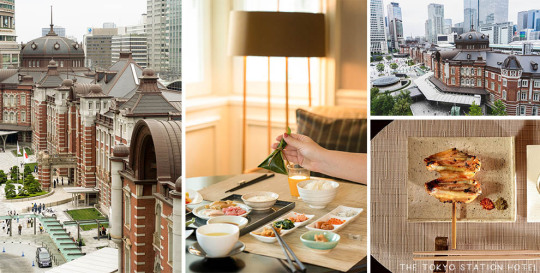
Located inside The Tokyo Station Marunouchi Building, INVITED guests praised The Tokyo Station Hotel for preserving its deep-rooted heritage, from QR codes attached to framed old photographs and notepads made of Japanese manuscript paper to staff wearing pillbox hats and train timetables hanging in the corridors. The property’s sumptuous Japanese and European style buffet breakfast should be high on any traveller’s bucket list, displaying around 110 items including rolled omelettes, sashimi, tempura and mini wagyu burgers.
Highly Commended – Dormy House Hotel (UK); Velassaru Maldives (Maldives); Hotel Relais Christine (France)
City Centre Hotel of the Year – The Norman Tel Aviv, Israel
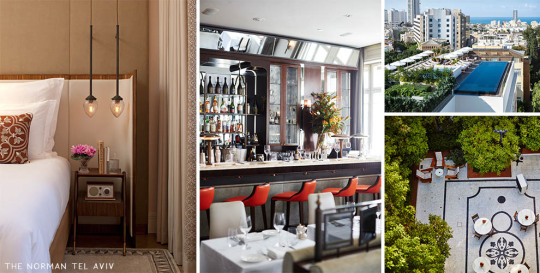
Located in a UNESCO-designated site with the world’s highest concentration of Bauhaus-style buildings, it was only a matter of time until The Norman Tel Aviv was named our City Centre Hotel of the Year. From a rooftop infinity pool offering unbeatable views of Tel Aviv, a restaurant serving the best Japanese food in the country to resident DJs and a private art collection including its own in- house curator, it is no surprise that The Norman is regarded as one of Israel’s best boutique hotels. The expert concierge can arrange bespoke experiences for guests including the chance for them to craft their own signature scents with a perfumer or giving them access to usually off-limits artists’ studios.
Highly Commended – Hotel Lungarno (Italy); Refinery Hotel New York (USA); DUKES London (UK)
Country House Hotel of the Year – Château La Chenèviere, France

Set along Normandy’s lush, north-west coast, Château la Chenevière ticks all the boxes of a grand yet welcoming country house hotel including marble fireplaces and velvet-backed beds as well as beautiful rose gardens with beehives, an outdoor pool and a tennis court – not to mention the fact that it’s dog-friendly. Both dining rooms serve delicious dishes prepared from fresh ingredients supplied by the on-site vegetable garden, where sustainable and natural permaculture techniques are in practice. The hotel’s speakeasy-style Zanzibar bar is not to be missed featuring a collection of the owner’s travel souvenirs and Calvados-themed cocktails such as the signature ‘Chenevière cocktail’ – a combination of pommeau (apple port), peach cream and champagne.
Highly Commended – Schlosshotel Kronberg (Germany); Stein Eriksen Residences (USA); Hotel Rangá (Iceland)
Resort Hotel of the Year – Hotel Villa Franca, Italy
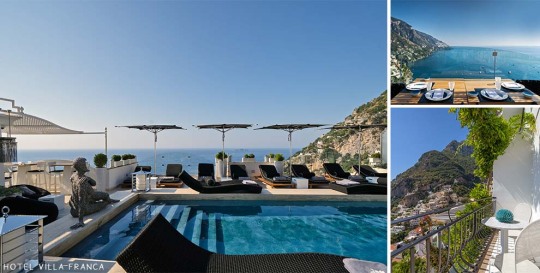
Perched high on the hill overlooking the town of Positano, Hotel Villa Franca has been awarded Resort Hotel of the Year for its top-notch facilities and wide range of experiences including an L-shaped swimming pool with stellar views of the Amalfi Coast, lemon-infused spa treatments to detoxify the body and a fine dining restaurant rooted in Campanian culinary traditions. The resort can arrange a special Amalfi lemon tour for guests, where they get the chance to taste the citrus fruits hanging from pergolas and sample them in homemade cakes, drinks and of course, limoncello.
Highly Commended – Nobu Hotel Ibiza Bay (Spain); Canaves Oia Suites (Greece); Keemala (Thailand)
Mystery Inspectors’ Excellence Award – Hemingways Nairobi, Kenya

Set between Nairobi National Park and the foot of the Ngong Hills, Hemingways Nairobi offers personalised service with the kindness inherent to East African culture. A bespoke butler service ensures guests are catered to their every whim, from tailor-made afternoon tea and arranging outings to The Giraffe Centre or the Karen Blixen Museum, to adjusting their customised pillows, setting out their nightcap and packing their suitcase for departure.
Highly Commended – Grand Hôtel du Palais Royal (France); Pimalai Resort & Spa (Thailand); Rockliffe Hall (UK)
Sustainable Innovator of the Year – Arima Hotel, Spain
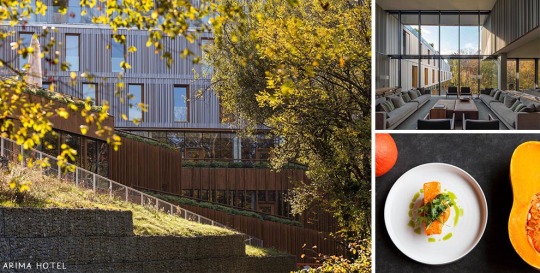
Hidden among the trees in the Miramón Forest of San Sebastián, Arima Hotel’s building structure is named as a prototype of zero-energy buildings, marked by the European Union as a mandatory standard to mitigate the effects of climate change. Its savings in CO2 emissions compared with a standard construction are similar to the carbon that 15,000 trees would absorb annually. From clean energy systems, sulphate-free toiletries to a menu inspired by locally-grown ingredients at veggie-focused fine dining restaurant Misura, the hotel has set a new benchmark in terms of environmental and social responsibility, as evinced by its rigorously audited Passivhaus qualification. Overall, 77 per cent of Arima Hotel’s energy needs are fulfilled from aerothermal and geothermal power.
Highly Commended – Susafa (Italy); Petit St Vincent (St Vincent & The Grenadines); Domaine de Manville (France)
Stay Small, Stay Considerate Award – Lefay Resorts, Italy
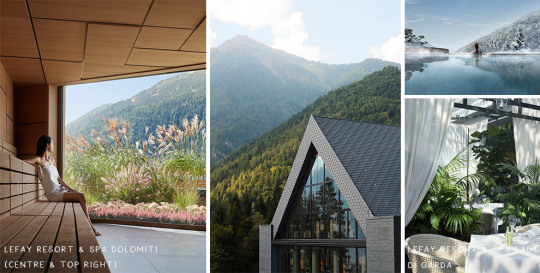
Created around the philosophy that personal wellness should never overlook environmental wellness, Lefay Resorts is fully committed to operating in the most responsible way possible, whilst creating a haven of luxury and wellbeing. As the first Italian hospitality company to sign an agreement with the Italian Ministry of the Environment aimed at neutralising C02 emissions, both its hotels in Lake Garda and The Dolomites (which opened in August 2019) are 100% carbon neutral. The company offsets its direct CO2 emissions and those of travelling guests through the purchase of CERs credits in accordance with the Kyoto protocol. Established from the outset with landscape protection and energy efficiency at the fore, great efforts are also taken to ensure the guest experience is grounded in sustainably practices. All the products used in its spa are vegan, free from parabens, SLES (a detergent that causes skin irritation), colourings and preservatives. Lefay also handpicks its food suppliers ensuring they adhere to strict environmental standards with 66% of ingredients sourced directly from the local provinces. The company’s results and objectives are summarised in an annual Sustainability Report that is published on its website.
Highly Commended – Tabacón Thermal Resort & Spa (Costa Rica); AKARYN Hotel Group (Thailand); Gaya Island Resort (Malaysia)
Most Inspirational Interior Design – Castello di Reschio, Italy

Nestled amongst rolling hills on Italy’s Umbria-Tuscany border, Castello di Reschio is a thousand-year old castle which has been meticulously restored and stylishly reimagined by architect Count Benedikt Bolza and his wife, Nencia Corsini. The hotel’s rooms and suites have been imbued with personality and panache, thanks to an organic approach to contemporary design coupled with subtle references to the fascinating characters who once lived here. Count Benedikt designed much of the furniture and lighting himself and sourced rare pieces from Italy’s below-the-radar antiques markets and art fairs.
Highly Commended – Le Coucou Méribel (France); Gangtey Lodge (Bhutan); Ksar Char-Bagh (Morocco)
Most Intimate Bedroom – Cap Rocat, Mallorca
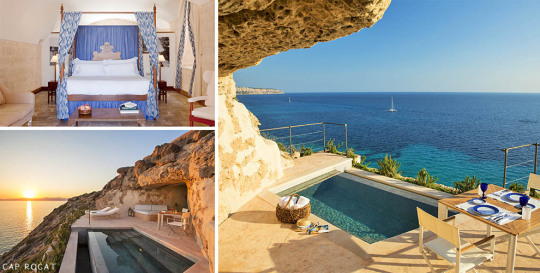
Housed within a striking 19th-century military fortress, Cap Rocat’s three Sentinel suites are wonderfully secluded, carved out of the rocks that the fortress was built into, with private infinity pools featuring unobstructed views of Palma Bay. The three intimate rooms, which once served as watchtower spots, are each decorated with sumptuous king-sized beds, refined rugs, soft Mediterranean fabrics and a private terrace. Maps are given to guests upon check in so they can find their way along the hotel’s secret corridors and pathways, some still partly covered with plants.
Highly Commended – Thorngrove Manor (Australia); Carmo’s Boutique Hotel (Portugal); Le Grand Bellevue (Switzerland)
Most Mindful Wellness Retreat – Castle Hot Springs, Arizona
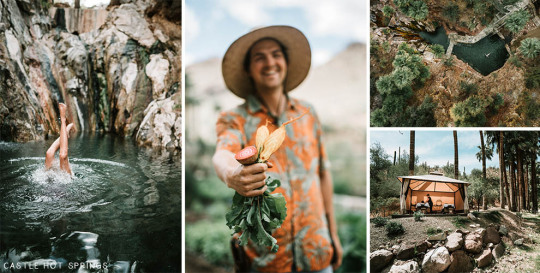
Disconnect from the busy world and reconnect with yourself and nature at Castle Hot Springs with the rustic Bradshaw Mountains as the backdrop. The resort’s remote location, tucked in a rugged canyon surrounded by Saguaro Cacti, makes it an oasis in every sense of the word. The star of the show are the three hot springs that well up from deep within the desert surface and offer pristine 115-degree waters filled with revitalising minerals. The waters are also piped through for guests to enjoy in their rooms and to feed the three-acre sustainable farm. Guests can further take in the landscape doing immersive activities like hot springs Paddleboard Yoga and Via Ferrata – a state of the art course and one of only a handful in North America. Castle Hot Springs spa services are provided in custom cabanas set along the spring water creek under towering palm trees, and offer fully customised treatments using hot stones from the springs.
Highly Commended – Quinta da Comporta (Portugal); Lefay Resort & SPA Dolomiti (Italy); Spa Village Tembok Bali (Indonesia)
Most Intense Bespoke Experience – The George, New Zealand
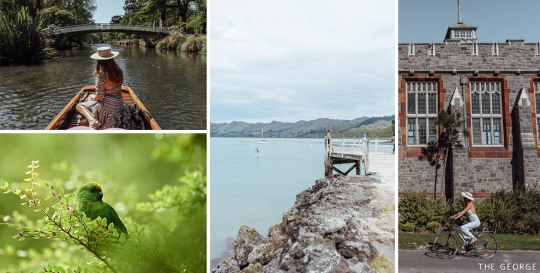
Drawing upon the traditional Maori cultural values of care and guardianship, The George offers an exclusive half-day Flight Path Conservation Experience accompanied by an Endangered Species Ranger. Guests are taken on a half day trip to Canterbury’s forest valleys to support the conservation efforts for the critically-endangered orange-fronted Kakariki, a native parrot whose numbers are estimated at fewer than 300. Once a year, by special arrangement, guests can even release one of these treasured birds into the forest. A portion of every flight from the Conservation Experience is donated to the recovery programme.
Highly Commended – Nobu Hotel Ibiza Bay (Spain); Milaidhoo Maldives (Maldives); Pangkor Laut Resort (Malaysia)
Best Gourmet Experience – The Seminyak Beach Resort & Spa, Bali
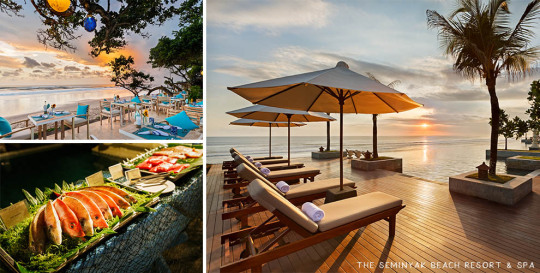
Located in the heart of Seminyak in Bali, The Seminyak Beach Resort & Spa has launched Bali’s first ever Dine in the Dark event, inviting guests to discover food in a whole new way – without seeing it – in collaboration with Yayasan Dria Raba, a donation-only orphanage for visually-impaired children. Held in the resort’s darkened Klass & Brass private dining room, the six-course sensory dinner experience has been thoughtfully curated to focus on texture, aroma and flavour, while being served and guided by children from the orphanage. The aim is to help provide the children with employment opportunities and basic hospitality training while raising awareness for the vision-impaired people of Indonesia. The experience is available any day of the week with a minimum one day reservation and at least eight participants.
Highly Commended – The Atlantic Hotel (Channel Islands); Castle Hot Springs (USA); Halcyon House (Australia)
Local Food Champion – Chef Marc Collins at Wentworth Mansion, Charleston
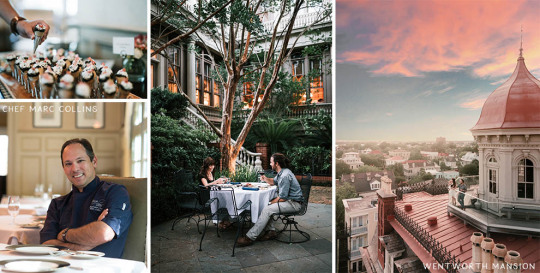
Located in central Charleston, Wentworth Mansion’s restaurant Circa 1886, is regarded as one of the best in the region. Beyond working with local farmers and fishermen to curate the best local Southern dishes, their executive chef Marc Collins also holds the title of South Carolina Chef Ambassador. Chef Collins co-founded the Charleston Wine + Food Festival in 2006 with the objective to spotlight Charleston and the Lowcountry’s diverse culinary and hospitality community. In 2019, he launched a unique menu concept that takes guests from South Carolina’s humble beginnings to Charleston’s Southern-modern foodie scene. Culinary highlights include the Broken Arrow Axis Venison with sunchoke hash and sunflower seed butter and Piedmontese Oxtail with conch fritter and mustard greens.
Highly Commended – Chef Salvatore Minneci, Susafa (Italy); Chef Carvison Pratt, Sailrock Resort (Turks & Caicos); Chef Jim Hopkins, Stein Eriksen Residences (USA)
Hotel Hero Award – Michael Ferreira, Guest Experience Manager of Le Barthélemy Hotel & Spa, St. Barths
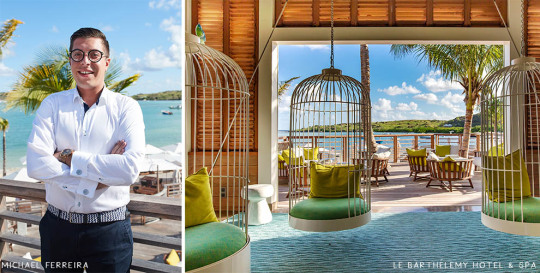
Located in chic St. Barths, Le Barthélemy Hotel & Spa’s personalised service is exemplified through Guest Experience Manager Michael Ferreira, who goes above and beyond to put a smile on every guest’s face. Michael’s proactive attitude has been demonstrated though arranging a leg massage for a guest who returned from the day’s exploration with a leg pain, and anticipating the needs of a cancer patient who was checking in with a unique welcome amenity of detox juices, sun cream and hat. Always looking out for his guests, Michael has accompanied a Portuguese guest to the hospital to help translate and make sure that the guest was well-taken care of. Michael showed true dedication when two guests fell in love at Le Barthélemy and spontaneously decided to get married – he organised the entire wedding event, from master of ceremony to musicians and floral arch, within 24 hours.
Highly Commended – Laksiri Perera, The Fortress Resort & Spa (Sri Lanka); Harold Shepherd, The Sandpiper (Barbados)
Travel Agents’ Hotel of the Year – Hôtel Relais Christine, France
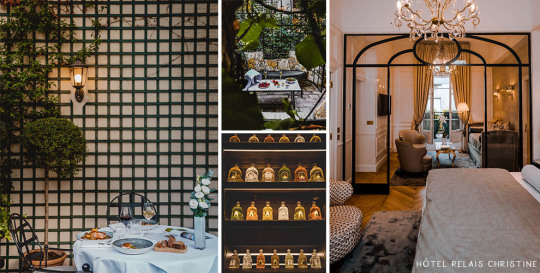
Built atop a 13th-century Augustinian monastery in Paris’ Saint-Germain-des-Prés district, Hôtel Relais Christine was commended by travel agents for its refined calm, remarkable home-from-home ease and vintage glamour. From a secret garden with beehives producing honey for the hotel’s breakfast table to the basement Spa Guerlain with its medieval stone vaults and impressive display of Guerlain perfume bottles, everything about this hotel exudes intimacy and charm.
Highly Commended – Viceroy Bali (Indonesia); Hotel Vilòn (Italy); Casa Angelina (Italy)
Most ‘Liked’ Hotel of the Year – Halcyon House, Australia

Found on Instagram as @_halcyonhouse, it is without a doubt that Halcyon House‘s colourful and eclectic interiors and idyllic beachside setting make it so Instagrammable. The hotel is often lauded for its ‘Instagram-worthy interiors’ including its unique mix of ocean blue décor juxtaposed with bold clashing prints, vintage cameos and beachside paraphernalia. Everything about the hotel is photogenic from the blue and white wicker chairs in Halcyon’s Paper Daisy restaurant to the blue and white candy-striped loungers next to the pool area.
Highly Commended – Canaves Oia (Greece); Castello di Reschio (Italy); Cap Rocat (Spain)
Digital Excellence Award – Triumph Hotels, New York
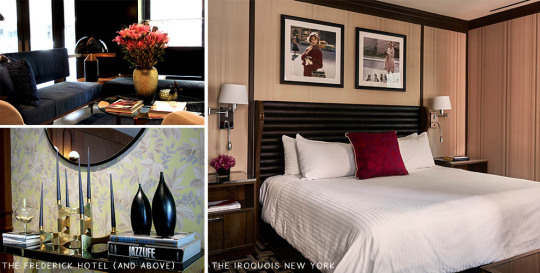
Triumph Hotels underwent a revamp of all their digital platforms in 2019, including those of SLH member hotels The Frederick Hotel and The Iroquois New York. Reflecting the aesthetic and contemporary edge of the hotels, the newly designed websites employ an experiential approach that brings to life the destination and energy of New York City.
The post The Trailblazers of Boutique: SLH Award Winners 2020 appeared first on Small Luxury Hotels.
from Small Luxury Hotels https://ift.tt/33d1PBC Publish First on
0 notes
Text
Tokyo Restaurants Primed for the Olympics Face a Summer Without Tourists

The iconic Omoide Yokocho in Tokyo where restaurants are closed | Frank Striegl
Without the promise of Olympic-sized crowds, tourist-focused restaurants and ramen shops are struggling to survive
Note: Frank Striegl runs Tokyo Ramen Tours, a tour company that has business relationships with multiple sources in this story.
Two months ago, Tokyo’s hospitality industry felt a swell of optimism about 2020. It’d already been a banner year — inbound tourism to Japan was surging (up more than 250 percent since 2012) — and the swell would be punctuated by the Summer Olympic Games in July. The city’s 150,000 restaurants were preparing for another massive wave of domestic and international visitors, with crowds expected to reach nearly 10 million, and Goldman Sachs projecting $5 billion in additional spending.
That optimism quickly transformed to uncertainty and dread when cases of COVID-19 began to spread around the world. For a while, some Tokyoites held out hope that the Olympics might take place as scheduled — it was months away. But on March 24 the International Olympic Committee announced it was officially postponing the games a full year, until July 2021. Combined with the national emergency declaration announced on April 7 — which technically allows restaurants to remain open but puts limits on hours and other aspects of operations — it’s been an unfathomable double whammy for an economy that already contracted in Q4 last year.

A shuttered restaurant on Omoide Yokocho with a hand-written closed sign
Like most of the world’s major thoroughfares today, Tokyo’s iconic Omoide Yokocho (Memory Lane) in the touristy Shinjuku area appears startlingly empty. The narrow alley of miniature counter-seat bars and yakitori restaurants that usually buzzes with tourists during the spring’s cherry blossom season is currently a ghost town, lined with shuttered restaurants and hand-scrawled “closed” signs taped to the doors. Reports show that bankruptcies in the hospitality industry are already mounting. Vendors at the famous Tsukiji fish market have reportedly lost between 70-80 percent of their business, and one local sushi chef told CNN that the economic damage already surpasses the 2011 earthquake and tsunami.
While some restaurants have successfully pivoted to delivery, take-out culture is not as well established in Tokyo as one might think. While grab-and-go food options abound, there is still a strong emphasis on traditional family meals cooked at home, and many locals live in small apartments where they don’t want to deal with excess trash from deliveries. Until recently, pizza and Chinese restaurants still made up the majority of take-out options, with many other restaurants eschewing delivery for fear their food would deteriorate in quality or even become unsafe to eat. Then, as businesses flooded onto UberEats in March, without substantial user growth, the platform became crowded and impossibly competitive.

Outside Regamen, where English-language advertisements draw customers

Staff at ramen restaurant Regamen
For restaurants whose business model relied primarily on tourists, or the incoming wave of tourists for the Olympics, delivery wasn’t much of an option anyway. Bocata is a 12-seat Spanish bocadillo restaurant in Tokyo’s Yutenji neighborhood. Owner Takahiro Katsumura was hoping to draw Spanish nationals looking for a taste of home during the Olympics, but the emergency declaration saw his weekend sales decline by 50 percent, and he was eventually forced to close altogether, at least for now. “There is a big chance that I might even have to close permanently if this situation drags on well into the rest of the year,” says Katsumura-san.
The themey Ninja Restaurant, which recreates an Edo-era village complete with ninja performances, treated visitors in Shinjuku to dinner and a show for almost 20 years before it recently closed its doors permanently. While the restaurant still runs a branch in Akasaka, if the situation worsens, it may too be forced to close.
Ramen restaurants in particular have felt the pinch — ramen has become the go-to dish for foreigners visiting Japan, and many operators made huge investments in expectation of an Olympics influx, costs they now have to absorb. Okumura-san owns Shinbu Sakiya, a ramen restaurant in the tourist-heavy Shibuya area of Tokyo, not far from the famously swarmed pedestrian crossing. Okumura-san expected the Olympics to bring record-breaking revenue, projecting a 135 percent increase in business in July and August alone. Instead, sales have trended sharply in the other direction, with year-over-year revenue down in March by $62,000 USD and April set to decline by $83,000 USD.
But the damage had been done. In preparation for the Olympics, Okumura-san revamped his menu with foreigners in mind, advertising vegan, gluten-free ramen, and “non-pork” (chicken and fish) ramen options, and cranking up social media marketing to attract non-Japanese diners. He also bought a snazzy touch-screen ticket machine with six different languages. Those investments weren’t cheap — gluten-free noodles cost 350-400 yen per 100 grams, eight times the cost of standard ramen noodles (about 50 yen for 100 grams), but they only have a shelf life of six months (if the current situation goes on past summer, he’ll have to toss them). And that ticket machine cost around $37,000 USD, double what a standard machine might cost; it’s a luxury he can no longer afford.

A sign outside Shinbu Sakiya advertising a new menu of ramen options

Sign advertising vegetarian dumplings outside Kourakuen
Across the street from Shinbu Sakiya, a branch of the ramen chain Kourakuen recently introduced vegetarian gyoza dumplings aimed specifically at foreigners (only an estimated 3.8 percent of Japanese are vegetarian). A custom-printed “Recommended Menu” sign out front advertises the new plant-based options in both English and Chinese. Similar investments were made by another ramen shop, Regamen, which opened in October in the Kita-Sando area not far from the new Olympic stadium. A fresh bright paint job and new English signage — “YES, WE’RE OPEN” — were meant to draw visitors. The owners also paid to print both English and Chinese-language menus, and spent time training the staff to field special substitution requests from tourists. Now, the team is trying re-focusing on catering to locals.
When he’s not operating his shop Ramen Emoto in the up-and-coming neighborhood of Naka-Meguro, Emoto-san is busy receiving tourists on ramen walking tours through the city. [Disclosure: These are through the writers’ company, Tokyo Ramen Tours]. For the Olympics, he had begun planning a special “nagashi tsukemen” event, a take on the classic summertime experience of nagashi somen, in which guests snap up noodles as they race down a bamboo shoot. “I was definitely expecting more sales,” says Emoto-san, who also printed English menus for the occasion. “Since there had been an actual increase in tourists up to now, I think people across the country had really high hopes.”

Emoto-san of Emoto Ramen
Some restaurateurs remain positive about the future. “If we think about the coronavirus situation, it’s a good thing that the Olympics were postponed,” says Okumura-san, adding he’s thankful that the Olympics are just delayed, not canceled altogether. Emoto-san agrees. “With the virus still spreading around the world, business uncertainty will remain. We’ll just have to do our best to prepare until the Olympics is safely held next year. I’m hoping things return to normal around the world soon.”
Frank Striegl is a Filipino American born in Tokyo and raised on ramen. He consumes over 300 bowls of ramen a year while running his blog, 5 AM Ramen, and Tokyo Ramen Tours for visitors to Japan.
from Eater - All https://ift.tt/34HJJ9M https://ift.tt/2XIlNBK

The iconic Omoide Yokocho in Tokyo where restaurants are closed | Frank Striegl
Without the promise of Olympic-sized crowds, tourist-focused restaurants and ramen shops are struggling to survive
Note: Frank Striegl runs Tokyo Ramen Tours, a tour company that has business relationships with multiple sources in this story.
Two months ago, Tokyo’s hospitality industry felt a swell of optimism about 2020. It’d already been a banner year — inbound tourism to Japan was surging (up more than 250 percent since 2012) — and the swell would be punctuated by the Summer Olympic Games in July. The city’s 150,000 restaurants were preparing for another massive wave of domestic and international visitors, with crowds expected to reach nearly 10 million, and Goldman Sachs projecting $5 billion in additional spending.
That optimism quickly transformed to uncertainty and dread when cases of COVID-19 began to spread around the world. For a while, some Tokyoites held out hope that the Olympics might take place as scheduled — it was months away. But on March 24 the International Olympic Committee announced it was officially postponing the games a full year, until July 2021. Combined with the national emergency declaration announced on April 7 — which technically allows restaurants to remain open but puts limits on hours and other aspects of operations — it’s been an unfathomable double whammy for an economy that already contracted in Q4 last year.

A shuttered restaurant on Omoide Yokocho with a hand-written closed sign
Like most of the world’s major thoroughfares today, Tokyo’s iconic Omoide Yokocho (Memory Lane) in the touristy Shinjuku area appears startlingly empty. The narrow alley of miniature counter-seat bars and yakitori restaurants that usually buzzes with tourists during the spring’s cherry blossom season is currently a ghost town, lined with shuttered restaurants and hand-scrawled “closed” signs taped to the doors. Reports show that bankruptcies in the hospitality industry are already mounting. Vendors at the famous Tsukiji fish market have reportedly lost between 70-80 percent of their business, and one local sushi chef told CNN that the economic damage already surpasses the 2011 earthquake and tsunami.
While some restaurants have successfully pivoted to delivery, take-out culture is not as well established in Tokyo as one might think. While grab-and-go food options abound, there is still a strong emphasis on traditional family meals cooked at home, and many locals live in small apartments where they don’t want to deal with excess trash from deliveries. Until recently, pizza and Chinese restaurants still made up the majority of take-out options, with many other restaurants eschewing delivery for fear their food would deteriorate in quality or even become unsafe to eat. Then, as businesses flooded onto UberEats in March, without substantial user growth, the platform became crowded and impossibly competitive.

Outside Regamen, where English-language advertisements draw customers

Staff at ramen restaurant Regamen
For restaurants whose business model relied primarily on tourists, or the incoming wave of tourists for the Olympics, delivery wasn’t much of an option anyway. Bocata is a 12-seat Spanish bocadillo restaurant in Tokyo’s Yutenji neighborhood. Owner Takahiro Katsumura was hoping to draw Spanish nationals looking for a taste of home during the Olympics, but the emergency declaration saw his weekend sales decline by 50 percent, and he was eventually forced to close altogether, at least for now. “There is a big chance that I might even have to close permanently if this situation drags on well into the rest of the year,” says Katsumura-san.
The themey Ninja Restaurant, which recreates an Edo-era village complete with ninja performances, treated visitors in Shinjuku to dinner and a show for almost 20 years before it recently closed its doors permanently. While the restaurant still runs a branch in Akasaka, if the situation worsens, it may too be forced to close.
Ramen restaurants in particular have felt the pinch — ramen has become the go-to dish for foreigners visiting Japan, and many operators made huge investments in expectation of an Olympics influx, costs they now have to absorb. Okumura-san owns Shinbu Sakiya, a ramen restaurant in the tourist-heavy Shibuya area of Tokyo, not far from the famously swarmed pedestrian crossing. Okumura-san expected the Olympics to bring record-breaking revenue, projecting a 135 percent increase in business in July and August alone. Instead, sales have trended sharply in the other direction, with year-over-year revenue down in March by $62,000 USD and April set to decline by $83,000 USD.
But the damage had been done. In preparation for the Olympics, Okumura-san revamped his menu with foreigners in mind, advertising vegan, gluten-free ramen, and “non-pork” (chicken and fish) ramen options, and cranking up social media marketing to attract non-Japanese diners. He also bought a snazzy touch-screen ticket machine with six different languages. Those investments weren’t cheap — gluten-free noodles cost 350-400 yen per 100 grams, eight times the cost of standard ramen noodles (about 50 yen for 100 grams), but they only have a shelf life of six months (if the current situation goes on past summer, he’ll have to toss them). And that ticket machine cost around $37,000 USD, double what a standard machine might cost; it’s a luxury he can no longer afford.

A sign outside Shinbu Sakiya advertising a new menu of ramen options

Sign advertising vegetarian dumplings outside Kourakuen
Across the street from Shinbu Sakiya, a branch of the ramen chain Kourakuen recently introduced vegetarian gyoza dumplings aimed specifically at foreigners (only an estimated 3.8 percent of Japanese are vegetarian). A custom-printed “Recommended Menu” sign out front advertises the new plant-based options in both English and Chinese. Similar investments were made by another ramen shop, Regamen, which opened in October in the Kita-Sando area not far from the new Olympic stadium. A fresh bright paint job and new English signage — “YES, WE’RE OPEN” — were meant to draw visitors. The owners also paid to print both English and Chinese-language menus, and spent time training the staff to field special substitution requests from tourists. Now, the team is trying re-focusing on catering to locals.
When he’s not operating his shop Ramen Emoto in the up-and-coming neighborhood of Naka-Meguro, Emoto-san is busy receiving tourists on ramen walking tours through the city. [Disclosure: These are through the writers’ company, Tokyo Ramen Tours]. For the Olympics, he had begun planning a special “nagashi tsukemen” event, a take on the classic summertime experience of nagashi somen, in which guests snap up noodles as they race down a bamboo shoot. “I was definitely expecting more sales,” says Emoto-san, who also printed English menus for the occasion. “Since there had been an actual increase in tourists up to now, I think people across the country had really high hopes.”

Emoto-san of Emoto Ramen
Some restaurateurs remain positive about the future. “If we think about the coronavirus situation, it’s a good thing that the Olympics were postponed,” says Okumura-san, adding he’s thankful that the Olympics are just delayed, not canceled altogether. Emoto-san agrees. “With the virus still spreading around the world, business uncertainty will remain. We’ll just have to do our best to prepare until the Olympics is safely held next year. I’m hoping things return to normal around the world soon.”
Frank Striegl is a Filipino American born in Tokyo and raised on ramen. He consumes over 300 bowls of ramen a year while running his blog, 5 AM Ramen, and Tokyo Ramen Tours for visitors to Japan.
from Eater - All https://ift.tt/34HJJ9M via Blogger https://ift.tt/3cAREc3
0 notes
Text
June 9th: Free Day in Osaka/Media Reflection
Of all the cities in Japan, of all the secret alleyways that have led me astray along the revered paths of Tokyo and Kyoto, of all the forgotten rooms in the twenty-story buildings that litter the streets that require you to get in the tiniest possible elevator, Osaka may just be the most unexpected, unprecedented of spots visited while on this trip... though the reasons for why are likely not what one expect. I began my day at 10am, dreading waking up but feeling a sense of nascent guilt slowly bloom within the pit of my stomach, I stood and prepared for the day. I wasn’t sure what exactly I was going to do, but it seems like our entire class had their sites set on Osaka. I thought to myself, after discussing it with Alexandra and my roommates, “Y’know it’s the last free day; I don’t see the harm in taking the road more travelled for once.” That of course didn’t change my intention of scouring Osaka’s streets solitarily. The train ride was an hour, which gave me plenty of time to read a whopping ten pages of Volume 14 of 僕のヒーロー, while simultaneously trying to define nearly every unknown word I stumbled upon. I think I’ve gotten substantially better at predicting the meanings of Japanese words from context, paired kanji, and the radicals used in kanji. Anyways, I arrived in Osaka, and I was thoroughly convinced my map was incorrect... until I saw a few signs that ようこそ’d me into 大阪. I was thoroughly confused; my existing interpretation of Osaka had been forged by many video games and movies in the past (which I will explain further in my media reflection portion), but frankly the portion of Osaka that I had the privilege of traversing had probably subverted my expectations more so than any other location we’ve visited. It felt like I was in Washington DC, with the most noticeable difference being cars driving in the opposite direction and the fact that I was the only 外国人 within any 100m radius constantly. I was shocked to see a myriad of luxury cars, specifically Porsche’s and Ferrari’s. I think I encountered more in a few hours in Osaka than I did in one week in Tokyo. Since I arrived at 1pm and I hadn’t eaten anything at all since arriving, I immeadiely set out to find a restaurant that I could eat at. There were a few fully vegan restaurants around, and they were all a bit of a hike to get to, but I wasn’t dismayed for even a second. However, I made my 20-minute hike to the “first fully-vegetarian restaurant in Osaka turned vegan” only to not be able to find it whatsoever AND for google to tell me it was closed either way. There was fortunately still hope: from my 20-minute trek, I was placed substantially closer to another vegan restaurant than I was before, and oh my goodness at I glad I found it. I was fortunate multiple times over: I was fortunate enough to have taken a path that indirectly led me to “Paprika 食堂 Vegan”; I had made it just in time for last orders to be taken; and when I paid, my waitress commented on how suspicious it was to receive 555¥ exactly as change. My meal was delicious, reminiscent of sweet and sour chicken, but with seitan as the chicken substitute and other sorts of delicious veggies arranged. I’m in love with the Japanese style of “meal sets”. Having a variety of different foods you can try while still constituting enough to be a full-course meal is a technique I wish was more heavily utilized in America. After my meal, I continued to wander around Osaka, stumbling upon a myriad of intriguing, minimalistic statues and a Pop-Art inspired banner cascaded on the side of a building (but it was an English). Eventually, I returned home to relax for the rest of the day.
Media Reflection:
As a child (and honestly as an adult too), I adored the “Godzilla” brand and its products. I loved the toys, the movies, and a whole bunch of it’s video games. In fact, I would say the Godzilla series has likely had the largest influence over my perception of what Japanese cities truly looked like, since the majority of cities depicted in its various forms of media are Japanese cities. I’d argue that Tokyo and Kyoto have most often been shown on the big screen for Godzilla, but a few of his movies actually take place in Osaka for parts of it, namely “Godzilla vs. Biollante” and “Godzilla va Megaguirus”. Frankly, I’m dissappointed by the disturbing lack of a super-sentient plant-hive-mind kaiju and ancient, colossal mutated Japanese dragonfly wreaking havoc accord the city, but I guess I should’ve lowered my expectations. All joking aside, the movie and video-game depictions of Osaka have always painted a more traditional and humble picture of it, with plenty of shrines and Edo-period architecture around every corner. That’s why I was so taken aback by initial arrival: there wasn’t a single Edo-style building in site and the street design was so similar to Washington DC, I was thoroughly convinced the Japanese government has been hiding the secret to teleportation and they tested it on our train ride. Not only is Osaka in incredibly modern city, even more so than Kyoto, but it even feels completely westernized, with so myriad of Western-inspired brands and chains around every corner. Heck, within my 4-5 hours of being there, I don’t think I stumbled upon a SINGLE shrine. Within a 1km radius of our 旅館 in Kyoto, you could probably find 5, maybe 6 shrines. I found absolutely ZERO. Yet somehow, I found a Hard-Rock Cafe in Osaka. そう言う事が全然信じられませんよ. Upon further research, it seems the more traditional portions of Osaka are set closer to its palace, which surely should come as no surprise. Overall, I believe that the misleading depictions of Osaka in the media I absorbed may simply be due to the fact that they are quite dated and old, with quite a few of these Godzilla movies being nearly or over 20 years old.









0 notes
Photo

Tokyo is famous for being a city well-loved by foodies. A visit to Japan’s capital also includes beautiful cultural activities, both old and new. From street food stalls to lavish Michelin-starred restaurants to catching your own dinner, here’s a delicious guide to food in Tokyo!
The Best Food in Tokyo
Delicious halal wagyu cooked at your table
@r8d1 / Instagram
For delicious halal food in Tokyo, head to Yakiniku Panga in Taito-ku. That’s where I found top-notch wagyu beef served yakiniku style.
The menu boasts a range of local wagyu in all different kinds of cuts and varieties at reasonable prices. Simply order your selection and the staff will bring the meat to your table. You cook the meat yourself on a red-hot flame. I found the meats to go well with sides like kimchi, salad, Japanese rice, and bibimbap.
An opulent buffet in Shinjuku
The five-star Shinjuku hotel, Keio Plaza Hotel Tokyo Premier Grand, offers a slew of tempting culinary offerings. But to get the most out of my holiday budget, I made a booking at Glass Court for their Super Buffet.
The epic spread included live stations that cook up delectable dishes from all corners of the world for lunch and dinner. I indulged myself in succulent roast beef that was carved on the spot, al dente pasta in a myriad of sauces, as well as authentic sushi made with the freshest cuts of fish.
Discover Keio Plaza Hotel Tokyo Premier Grand
Explore the seasons through a multi-course kaiseki
When it comes to exceptional restaurants at Tokyo hotels, Junisoh at Hilton Tokyo offers some of the most luxurious Japanese dishes you’ll find in the entire city. While there’s a tempting menu of sushi and teppanyaki, come here for the multi-course hot and cold meal of kaiseki. Truly a Japanese experience to remember, the kaiseki meals are a perfect way to tune into the seasons through the senses of taste and sight.
In wintertime, look forward to warming dishes like hotpot and steamed egg custard prepared by chef Genta Aoyagi.
Discover Hilton Tokyo
Catch your own sushi and sashimi dinner
Sushi and sashimi are some of the biggest Tokyo attractions when it comes to food and the seafood here doesn’t get fresher than what you’ll find at Zuo in Shinjuku. This unique eatery includes an indoor pond that snakes around the restaurant.
The pond is brimming with red snapper, flounder and mackerel. I paid a small fee for the fishing experience and caught my own dinner. The craft chefs turned my catch into delectable sushi and sashimi. They also had my fish grilled, steamed or fried with various sauces.
Blur the lines between art, food, and performance
If you’re looking for an exclusive dining experience that toes the line between food and art, make a beeline for Tapas Molecular Bar in the Mandarin Oriental.
Perched on the 38th floor, the restaurant has a chef’s counter arrangement, where the chef prepares your meal on the counter from opposite you. This is where I experienced two hours of various bite-sized dishes prepared by talented chefs using molecular techniques. It was truly an experience of a lifetime and well worthy of its Michelin star!
Discover Mandarin Oriental Tokyo
Taste the best of Japanese temple cuisine
@brigdau | Instagram
Even if you have visited Japan many a time, it’s likely that you haven’t tried Japanese temple cuisine. In this style of cooking, killing is not allowed and the food is prepared by Buddhist monks.
If you’re interested to try the best of temple cuisine, visit Kamakura Fushikian, where I found their vegan meals prepared with great detail; mindfully and simply. I choose from a menu of three, four or nine-course set menus. I love that they offer so many small dishes filled with humble ingredients that were surprisingly tasty.
Savour a Michelin-starred lunch bento
Centrally located in Akasaka, Totoya Uoshin is a humble little restaurant that sparkles with the shine of a single coveted Michelin star.
I got a front row seat at the bar, where the amazing dishes were being prepared in the open kitchen. Although the restaurant specializes in kaiseki meals which are perfect for dinner, I came for lunch. Their bento sets are value-for-money and include several little seasonal dishes that paired well with hot tea or sake.
Eat like a local at train stations
The sprawling metropolis of Tokyo is connected with a network of trains. But confusion is not the only thing I found in this underground labyrinth – the food in Tokyo stations is terrific!
At Tokyo Station, I loved strolling through Kitchen Street. It is a long food court where stall hawkers whip up quick bites like tempura, sushi, omelettes, and soft-serve ice cream. I took my food to-go and ate on the train!
From feasting on elaborate multi-course dinners to Michelin-starred bentos for lunch, Japan has it all when it comes to dining like royalty. However, on the streets is where you’ll find cheap eats arguably just as good from on-the-go street food at train stations and even at your local convenience store. Whatever it is you’re after, this Japanese capital is every foodie’s dream.
Where to Stay Let’s Go!
Where to Stay
Where to Stay during your Trip
Find Hotels in Tokyo
Let’s Go!
Flights to Tokyo
The post Foodie’s Guide to Tokyo appeared first on Expedia Singapore Travel Blog.
0 notes
Photo

🍽• • • Rhubarb -Shiso jelly. • • • ❤Like 🚀Share 📲Save 👨🏻🍳 ~ Chef @jean_sebastien_clapie 👏 ___________________ 📸 All rights & credits are solely to the owners(s) 📌 Stay tunned for news & new content 👇 👇 👇 👇 👇 @pinchef.io ~ @pinchef.tr ~ @pinchef.ru : : : #instagood #instagram #instafood #instachef #food #eat #miami #newyork #california #vegan #lunch #breakfast #foodie #foodporn #privatechef #chefslife #love #brunch #restaurant #gastronomy #luxury #finedining #plating #reels #pastry #art #yummy #dessert #hungry #fruits (at Salesforce Tower Tokyo) https://www.instagram.com/p/CdZsEx0IUhX/?igshid=NGJjMDIxMWI=
#instagood#instagram#instafood#instachef#food#eat#miami#newyork#california#vegan#lunch#breakfast#foodie#foodporn#privatechef#chefslife#love#brunch#restaurant#gastronomy#luxury#finedining#plating#reels#pastry#art#yummy#dessert#hungry#fruits
2 notes
·
View notes
Text
an excerpt from this weekend
firstly, i would like to say - rest in peace, anthony bourdain. his knowledge and presence had such an influence on me as i grew up. i know he inspired so many others as well. as one of my longtime role models, his death was quite the shock to me and i hope to let others know that they are not alone and they can always seek help by confiding in others or to find hope in creative interests. i hope this post gives solace to those who have been affected by any disheartening thoughts.
i experienced a bittersweet weekend filled with happiness, melancholy, and curious longing for knowledge and kindness between others as i continued to think back on bourdain's philosophy towards culture and food. he was always open-minded, yet knowledgable, on the good and the bad between the places he's visited. he never failed to show appreciation for others no matter their race, gender, age, social status.. as i ponder his success, his influence continues as its helped me write this small piece from what i've experienced in the past couple days. please have patience as its been a while for me and this is also still a work in progress, but i hope you enjoy what i've came up with.
-
it was a hot and humid day. i had just parted ways with my best friend, meghan, from the ginza line after visiting harajuku together. she was visiting from my hometown of las vegas and was on her way to the airport to fly to another country to see her family. she made the kindest gesture to stop in japan to visit me before her family reunion.
“so this is shibuya crossing,” i said, “its kinda like the times square of japan.” i gestured towards the crowd as we both made our way from one end to the other.
“holy crap, people even stop to take photos?” she asked, as she pointed out the woman - an obvious tourist - sitting on the ground, cross-legged, in the middle of the street as her significant other snapped away photos with his DSLR. it wasn’t hard to miss the sight since they were the only still people in a sea of others who were walking on one end to the other as well, naturally.
i laughed, “yes, there’s so much to see here. i would say ten days would be the perfect amount of time to take everything in. was there anything specific you wanted to see while you’re here?”
“not really,” meghan said, “since i’m here for such a short time, i figured you could just show me around.”
and i did just that. within 2 days, we were able to visit cute cafes and amazing vegan restaurants (she’s been vegan for 4 years) in shinjuku, harajuku, and shibuya. we even stayed in the traditional neighborhood of edogawa, which was something new since it was located in a personally unexplored area a little closer to narita. rather than my usual destination of tokyo. it was nice to spend a couple days with my best friend of 10 years in the country that i now call home, the country she’s known me to adore.
sadly, after a fun weekend, we had to separate ways. we exchanged words of gratitude and took one last train together before we went in different directions to our next destination. the train doors opened, and i hugged her goodbye before getting off the train. i turned around to watch her leave and as the train doors closed, i waved and instinctively said the words, “see you.” - a common phrase in japan between friends that evokes more positivity on the usually sad-sounding goodbye. after a smile and a wave back from meghan, i then made my way to my next train.
at the station, i was waiting at the platform for my train ride that provided my 45-minute way home. crowds made their way to line up on the numbered floors alongside me, waiting for their next train as well. in just a few seconds, the next train approached, and 90% of the crowded platform boarded. the other 10%, including myself, stayed back to wait for the next train that followed.
in front of me, an older man spoke (in Japanese), “seems like many people take the train to Yokosuka, doesn’t it? our train will have more space.” he continued to speak, yet i couldn’t understand.
i smiled and nodded before speaking some quiet Japanese, “it seems so. i’m sorry, but my Japanese isn’t so great.”
“ah, excuse me,” he nodded and continued to apologize in Japanese. he paused.
“where are you from?” he asked, in English this time.
“America”, i said, “but i live in Ushiku now.” i continued in Japanese, a little louder with more confidence this time.
he continued in Japanese and gestured his hands from himself to me, “oh, we are both going to the same place.” he smiled.
“it seems so.” i replied in Japanese, returning a polite smile.
he then asked, in English, “do you have a green car ticket?” and pointed to the numbered floor below us.
“oh, no, i don’t.” i showed confusion. i knew i was boarding the next train, but i hadn’t paid for the extra fee of entering the green car, which had more luxury reclining seats and a train attendant to tend to paying guests.
the train started to approach, i was frazzled and looked for other queues to rush behind, so i could make my way to the regular entryways.
“ah, its okay, come with me. i’ll pay for you so we can sit together,” he gestured towards me with an open palm, not necessarily asking for my hand in return - but to show his openness of generosity.
i was hesitant, and before the train doors could close, i quickly made the decision to follow him without any time to verbally agree.
- to be continued, part two in progress -
(exact locations/town names were changed for privacy)
0 notes
Text
Ramen for all tastes
NOTICE: The prices mentioned are from before the COVID-19 pandemic.
Ramen (rah-men) is a Japanese dish, the preparation of which generally consists of Japanese noodles served in a meat-based broth, miso, soy sauce and includes garnishes or decorations such as pork or chicken slices, nori seaweed, cooked egg and chives. This dish has become increasingly popular in Chile, with many restaurants preparing it.
Ramen History
There are different stories that relate the origin of this dish and in this text I will tell you how it possibly originated according to different sources that were studied.
Between 1192 and 1333, during the Kamakura era, Japanese Buddhist monks who traveled to learn in China brought with them the advanced gastronomic technology of the neighboring country. They made simple udon noodles with hot broth and vegetables. Sort of like a primeval ramen. It can be attested thanks to the book “Teikin õrai” by the Japanese Buddhist monk Gen’s, which explains the above described. Later, in the early 1800s and thanks to the opening of Japan to the world, China began to influence with greater notoriety in the culinary traditions of the Japanese country and in its ways of eating. Little by little, the primitive ramen was being introduced into other strata of society, without suffering any “boom” at the moment.
In the following years, there was a great migration of the Chinese population to Japan. It offered, in street stalls, artisan Chinese noodles with the name of Lamen, which over time would be Ramen, a translation from Chinese of the word Lamian, which means: artisan elongated noodles. It is common to see “Lamen” restaurants, instead of “Ramen” in Paris, New York and many other cities, whose owners are Chinese.
"The Ramen Boom" comes after World War II. Japan bought flour in large quantities from the US, which made it possible to reduce the cost and make more Ramen, popularizing this nutritious dish that was evolving according to the Japanese region in which it was made. Gradually this dish was adopting the ingredients of each area, giving rise to different varieties that, currently, can be enjoyed throughout Japan. The best-known types of ramen are the Sapporo (in northern Japan), the Hakata-Fukuoka, the ones in Tokyo, the Kitakata, the Onomichi Ramen or the Asahikawa Ramen. On the island of Okinawa its Okinawa Soba are also well known, in addition to many others in the Japanese country.
Ramen in Santiago, Chile
With its strong, intense and very tasty flavor, Ramen, like the case of sushi, has spread throughout the world, including Chile. Currently, Ramen has become very popular in Chile, so I will recommend some restaurants (Low Cost) in Santiago that prepare this delicious dish.
-Goemon Ramen
It's a place in Providencia, it's simple , without great luxuries, where in the first instance the dish is paid and then they notify you when it is ready by your purchase number. You will find mainly four types of ramen, loaded with tradition and flavor, these are Tonkotsu, Shoyu, Miso and Paitan, also including a Vegetarian option. Best of all, they all cost $ 5.900 (CLP). I recommend Miso Ramen, which has miso soup, pork/chicken slices, egg, Nori, and chives.
Curious Fact: They give you a card, for each dish you buy they give you a stamp, when filling the card (12 stamps), they give you a free dish to choose.
-Kintaro Ramen
Located on Monjitas street, almost in front of the "Bellas Artes" subway exit. It is located in the same place that the legendary Japanese food restaurant occupied, led by chef and boss Kasumaza Suzuki, currently owned by Nobuyuky Noda. On the menu, they have more than 10 types of ramen, for all tastes, where prices start from $ 7.700 (CLP). I recommend, for lovers of spicy, the "Spicy Paitan" with double chili and spicy pork broth base, only for the brave.
-Gema Ramen
Located in the shed "Victor Manuel", in the corner of Bio Bio with Victor Manuel (Persa Bio Bio), is this ramen place that became the best known of the "Persa", due to the exquisite culinary technique, with influences and Japanese experiences of chef Patricio Cozano.
One of the most popular dishes is Shoyu Ramen, costing just $ 4.500 (CLP), making it one of the most accessible ramen places in Santiago. It should be noted that they also have a vegan option, which has the same price as the normal dish.
-Wonton Restaurant
Located next to China House Market, in Patronato, is Wonton Restaurant, with Japanese, Korean, Taiwanese and Thai cuisine. They have five versions of ramen. I recommend trying the pork Ramen, it costs $ 5,800 (CLP), which is a strong broth with vegetables, eggs and thin and tasty pork slices.
-Distrito Nikkei
This ramen shop is located in Franklin (Barrio Franklin), at the intersection of Calle San Isidro with Bio Bío. There are mainly three types of ramen, all with a cost of only $ 4,000 CLP, prepared by chef José Ozaki. There are also options for vegetarians, such as the "tofu ramen" ($ 4,000 CLP), with soy soup, carrots, fried tofu, fried eggplant, and chives. I recommend Tonkotsu ($ 4.000 CLP) consisting of fried pork, egg, chives, and carrots.
-Möbssie Café
Möbssie is a coffee shop, located on Santa Filomena street (Patronato), which a while ago, with Korean influences in its preparation, added two versions of ramen to its menu, Miso and Spicy, which due to its low price ($ 3.500 CLP), I couldn't stop recommending.
-Ootoya
Located in Constitución street, in the "Barrio Bellavista", is Ootoya. It's a small place but with a great Asian variety on its menu, these dishes are made by the chef of Chinese origin Peiyi Cai. In the eleven varieties of Ramen they have, a homemade pasta that he prepares is included in the broth. I recommend the Cha Shu Ramen, which has miso soup, cha shu, egg, corn, onion, and sesame ($ 7.980 CLP) and also the Omakase Ramen, which has miso soup, three different styles of pork, egg, chive, corn, and sesame ($ 8,680 CLP). It shoud be noted that also they have a vegetarian option.
Ramen is life <3, ITADAKIMASU!
Bastián Miranda H
0 notes
Text
17 cities selected as the culinary paradise of the world
From Hanoi to New York or Barcelona, each city has its own unique culinary culture, worthy of visitors to come and experience.
Tokyo (Japan) : Japan prides itself on having more Michelin-starred restaurants than the rest, with Tokyo accounting for the majority. In addition to sushi, Tokyo also has tonkatsu cutlet, unagi grilled eel, okonomiyaki pancakes or tofu dishes. The number of restaurants in Tokyo has increased dramatically, from expensive luxury locations to small shops, with a focus on high quality ingredients.
Hanoi (Vietnam) : Hanoi Old Quarter is considered an ideal place to explore the balance in the spice of Vietnamese cuisine. Visitors should experience locally-made street food such as pho noodles served with sweet and sour broth, pork and fish sauce or pate bread, cucumbers, herbs, fried onions and chili, and finish. Journey with unique egg coffee.
London (UK) : London is recognized as the world’s culinary paradise, highlighted by the abundance of diverse, new sidewalk bars covering the east of the city. Young talents come here to make a name for themselves, the bars are also growing, helping diners sip cocktails before or after meals.
Jaipur (India): Jaipur was one of the few places typical of Rajput cuisine – the warriors ruled most of Rajasthan state until the 1960s. Hunting and exploration were their main activity, so grilled dishes are the highlight, typically Laal maas – hot goat meat curry, served with white rice or bread.
New York : The chefs in New York are always new. There are 8 million people from all over living in New York, so the culinary experiences here are endless. The trend of food is always changing very quickly, but the classic dishes can be mentioned as oysters at the Grand Central Oyster Bar or the world’s best steak at Porterhouse.
Mendoza (Argentina) : In addition to the famous Malbec wine, visitors to Mendoza to enjoy asado – large steaks are perfectly baked. Try Azafran, one of Mendoza’s most popular restaurants thanks to local products. There is also Cava de Cano, a special private dining room, serving buffet with traditional homemade dishes such as Argentinian stew or empanadas.
Bologna (Italy): Bologna is considered as the number one culinary city of Italy. Many specialties are sourced here, most notably bolognese sauces and baloney sausages, or mortadella. Food devotees will find crowded eateries, street markets and a range of great options, from full to light snacks.
Lyon (France) : Lyon is the best place to enjoy French cuisine. The recommended location is a small beer bar with specialties from organ dishes such as beef stomach, or to Les Halles central food market. Also try cream cheese cheese, pink chestnut candy in tarts and croissants
New Orleans (USA) : Locals say the menu here is mainly seafood, processed by seafarers every day. Visitors should go to Dauphine Street for street food and vegan breakfast, to Freret Street to eat lobster, fried oysters and grilled beef, to Frady Street to experience a Southern meal.
Bangkok (Thailand) : Bangkok impresses with the strong aromas of chili, lemongrass, galangal and durian. This culinary paradise has it all, from fried oyster pavement stalls in Chinatown to the chain of trendy restaurant restaurants with steaks, or upscale restaurants.
Barcelona (Spain): The city not only has fresh seafood, family tapas bars, but also an important and influential culinary center. Barcelona also has many restaurants that own Michelin stars, and there are many attractive dishes at affordable restaurants.
Singapore : Nowhere else is it comparable to Singapore in terms of food diversity. In addition to affordable street food serving Malaysian, Chinese and Indian food, there are also Michelin-starred restaurants. Moreover, over the past decade, young chefs have also created a modern cuisine that only appears in Singapore.
Copenhagen (Denmark): The capital of Denmark has the best cafes in Europe, the movement to enjoy progressive wine and the ideal restaurant chain, worthy of experience. One of them is Amass, where guests can have lunch in the quiet garden.
Lima (Peru) : The colorful city of Lima on the Pacific coast is suitable for fishing, most famous for its ceviche, made from raw fish marinated in lemon juice and chili, served with onion and coriander fresh. Surprisingly, the cuisine is influenced by immigrants from China and Japan.
Fez (Morocco) : Fez expresses the unique Moroccan flavor better than Marrakech, featuring ingredients from colorful lamb heads and spices. There are many great places to enjoy, as well as cooking classes – where you can learn how to prepare typical Moroccan dishes like harira soup, Berber pancakes and tagines.
Chengdu (China) : Visitors can dine in any Chinese city, but Chengdu is the center of Sichuan cuisine, with lots of pepper and spicy dishes. Visitors should not miss hotpot with duck tongue, lamb and sliced beef, served with a variety of vegetables. The local tea room is the right place for dessert.
San Sebastian (Spain) : San Sebastian deserves to be the culinary peak of the world. The city is small but has countless Michelin stars and has two restaurants in the top 20 best restaurants in the world. What makes San Sebastian so appealing is the quality of its food. The small pubs sell everything from simple traditional dishes to high-class gourmet dishes, at quite cheap prices.
The post 17 cities selected as the culinary paradise of the world appeared first on The Travel Blog Site - Tip Travel Free In The World.
from WordPress https://nhavn.com/17-cities-selected-as-the-culinary-paradise-of-the-world/
0 notes
Text
The World’s Best Burgers as Picked by Stars of Gastronomy
(Bloomberg) — The humble hamburger rarely has a place in traditional fine dining, but for many top chefs it’s one of the food world’s greatest guilty pleasures.
It’s a simple dish that’s found everywhere and loved all around the globe. But where can you get the best one and what’s the secret to turning a handful of minced beef (or something else) and some bread into a delicacy? We asked the culinary elite — chefs laden with Michelin stars and other accolades — for their favorite burgers when they are having a sneaky time out from gastronomy.
Here are their picks.
Australia Burger Project, Sydney
Neil Perry of Rockpool Bar & Grill is the big-name chef behind Burger Project, which works with local suppliers. The patty is hand-made, 100% grass-fed beef. Try the American, with Cape Grim beef, cheese, pickles, onions, mustard, secret sauce & rose mayo; or a simple cheeseburger. Chosen by Scott Collins of MEATliquor, London
Butchers Diner, Melbourne This 24-hour, hole-in-the wall joint with a counter and stools is a favorite with chefs who enjoy its unfussy food with high-quality ingredients. The hamburger is a 120-gram beef patty with tomato sauce, pickles & mayo in a milk bun. Chosen by Ashley Palmer-Watts, formerly of Dinner by Heston Blumenthal, London
Butter, Sydney Butter is a hybrid sneaker, fried chicken and Champagne bar in Surry Hills. If that sounds an unlikely setup, it is the project of respected chef Julian Cincotta and the team from Thievery restaurant in Sydney. The OG Chicken Sandwich is not to be missed. Chosen by Josh Niland of Saint Peter, Sydney
Mary’s, Melbourne This is an outpost of a Sydney chain, with loud music, natural wines and an American vibe. Founders Jake Smyth and Kenny Graham favor local suppliers for their meat and wines, and big flavors. The cheeseburger is a must unless you’d prefer the vegan menu. Chosen by Andrew McConnell of Cutler & Co., Melbourne
China Honbo, Hong Kong
This homage to the classic American burger joint serves great food. The patties are made with Double Gold American beef from Wisconsin, served in a potato milk bun. The double cheeseburger is the signature option. Chosen by Shane Osborn of Arcane, Hong Kong
WANT MORE? Upgrade the luxury in your life with the Pursuits Weekly newsletter. The best in high-end autos, food, real estate, fashion, culture, and lifestyle delivered every Wednesday.
Denmark Gasoline Grill, Copenhagen Fresh organic burgers are cooked at this walk-in joint, which is attracting attention far beyond Denmark. Housed in a former gasoline station, it has a short menu like a simple roadside grill. It’s worth going off piste with the vegetarian Green Burger. Chosen by Jamie Lee of Kødbyens Fiskebar, Copenhagen; Clare Smyth of Core by Clare Smyth, London
France Badia, Grand Hôtel Thalasso, Saint-Jean-de-Luz This grand old hotel overlooking the bay of Saint-Jean-de-Luz is an idyllic spot to eat. And Le Burger is particularly good, featuring truffled bread, Charolais ground beef, Basque sheep’s cheese and Espelette pepper ketchup with fries. Chosen by Shane Osborn of Arcane, Hong Kong
Bioburger, Paris
As the name suggests, this Parisian restaurant serves organic burgers and they are full of flavor. One favorite is Le Poivre: a choice of beef or vegetable patty with farmhouse cheddar, tomato, salad, onion jam and pepper sauce. It’s like eating steak au poivre on a bun. Chosen by Greg Marchand of Frenchie, Paris
CAB Comptoir à Burger, Biarritz This restaurant is located close to Les Halles, the daily market in Biarritz, from which the chefs source the freshest of produce. The buns are cooked to a special recipe and all the sauces are homemade, says Paris-based chef Hélène Darroze. Try Le Parm, with a Parmesan tuile, Mozzarella and arugula and pesto with sun-dried tomatoes. Chosen by Hélène Darroze of Hélène Darroze, Paris
India Swati Snacks, Mumbai
Burgers don’t have to be about a chunk of meat. Try the Vada Pav at this popular vegetarian cafe. Fried potato dumplings are served in buttery soft buns and laced with sinus-clearing spicy chutneys and deep fried green chilis. Not for the fainthearted. Chosen by Ravinder Bhogal of Jikoni, London; Prateek Sadhu of Masque, Mumbai
Italy Lucernaio Pub, Ragusa This pub in Sicily serves an excellent sausage burger with black olives, radicchio, stewed onion and Ragusano cheese, says Italian chef Ciccio Sultano, who holds two Michelin stars for his Sicilian haute cuisine. “It’s my go-to order if I am there,” he says. Chosen by Ciccio Sultano of Duomo, Ragusa
Japan MOS Burger, Tokyo This Japanese chain has been serving burgers adapted to Japanese tastes since 1972. Try the Rice Burger served with grilled beef, sweet soy and BBQ sauce between patties of compacted rice. The Kinpira Burger is a great vegan option. Chosen by Hisato Hamada of Wagyumafia, Tokyo
Wagyumafia, Tokyo The Cutlet Sandwich from Wagyumafia at Nakameguro station is made with thick-sliced pure Kobe beef, breaded and deep fried, sandwiched between two slices of Japanese milk bread with a secret house-made sauce. It harkens back to the original burger at Louis’ Lunch in New Haven, yet is distinctly Japanese, says three-Michelin star chef Kyle Connaughton. The prices are something else. The budget (Zabuton) version is 5,000 yen ($45.50) rising to 50,000 yen for the Kobe Champion. Chosen by Kyle Connaughton of Singlethread, Healdsburg, California
Mexico Hamburguesas al Carbón Torreon The inexpensive charcoal-grilled burgers at this street stand near Pushkin Garden are world class, according to Mexican chef Enrique Olvera, whose Pujol places at 12 in the current ranking of the World’s 50 Best Restaurants. Chosen by Enrique Olvera of Pujol, Mexico City
El Rey del Taco, Mexico City Mexican chef Martha Ortiz prefers tacos to burgers. El Rey del Taco covers both bases with the Cheeseburger Taco, which features a grilled patty with Chihuahua cheese served in flour tortillas with mayo, tomato and avocado. Chosen by Martha Ortiz of Filigrana, Mexico City
New Zealand Fergburger, Queenstown New Zealand chef Josh Emett is a big fan: “You will always remember you first Fergburger. First, there’s the long queue, and then the care taken to put them together so they are all picture perfect. I love a bit of avocado and bacon in anything and these burgers never disappoint.” Chosen by Josh Emett of Rātā, Queenstown
The post The World’s Best Burgers as Picked by Stars of Gastronomy appeared first on Businessliveme.com.
from WordPress https://ift.tt/38Lz2Vd via IFTTT
0 notes